Day 2 of a five day Spring Migration tour today. The fog first thing burnt off before we met up and a nice morning was in prospect with sunny intervals and lighter winds. We made our way back east and slightly inland, to the Glaven Valley for our first stop of the day.
A Song Thrush was singing as we got out of the car and a Chiffchaff was flitting around in the branches above our heads. As we walked up the lane, a variety of different warblers were singing. A Sedge Warbler was pouring out its scratchy song from the reeds in the meadow beyond and performed a short song flight. A Cetti’s Warbler shouted at us from deep in the hedge. A Blackcap sang from the bushes.
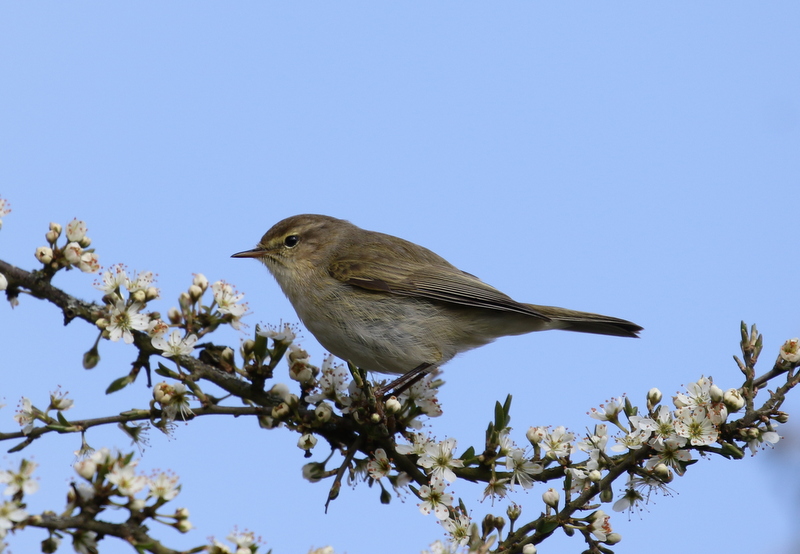 Chiffchaff – lots of warblers were singing from the hedges this morning
Chiffchaff – lots of warblers were singing from the hedges this morning
A little further along and we noticed some movement low down in the hedge beside the land. As we watched carefully, out popped a pair of Lesser Whitethroats. They were rather grey over all, clean grey headed and grey-brown on the back, with a white throat and rather whitish underparts – neat little birds. They can be rather skulking so it was great to see them out in the open. Then a bit further still and we heard a Common Whitethroat singing, which also perched up nicely for us. We could see its rusty brown wings, browner back and white throat contrasting with buffy-pinkish breast. It was nice to see the two species like this in quick succession.
We had hoped to find a Cuckoo along here at least, but there was no sound of it so we turned to walk back. We had only gone a few yards when it started up from across the meadows back from where we had been standing. It seemed to be taunting us, because when we got back there again it promptly stopped! Still it is always nice to hear a Cuckoo in the spring. A Brown Hare sat up in the sunshine along the edge of one of the fields.
 Brown Hare – enjoying the morning sunshine
Brown Hare – enjoying the morning sunshine
On the way back to the car, we could hear a Treecreeper in the trees and then picked it up climbing straight up a tree trunk. A Goldcrest was also singing but was tucked deep in cover. A Sparrowhawk circled up in the distance, high into the sky, before folding its wings in and plummeting vertically back down. A Yellowhammer flew over calling.
As we came out of the trees by the meadow, we could see a Barn Owl out hunting. It flew round over the grass, focused intently on the ground below. It came straight towards us and looked like it would come past, but seemed to notice us standing by the road and turned away again. It dropped down into the grass at one point, but came up empty talonned, before working its way over to the back and disappearing from view.
 Barn Owl – out hunting in the middle of the morning
Barn Owl – out hunting in the middle of the morning
With the weather starting to warm up nicely, we made our way over to one of the heaths. Despite the improvement in conditions, it was still rather quiet at first as we walked round, and we couldn’t find any Dartford Warblers. There were still large patches of hailstones from last night on the ground along the edge of the patches of gorse, so it was still cold down at ground level. We eventually heard a Willow Warbler singing from the birches.
We decided to see if any Adders were still trying to warm themselves up this morning, so we headed over to a favourite spot. We hadn’t been looking long when one slithered away into the undergrowth as we approached. But a second Adder was still curled up on the ground and we managed to get a great look at it before it too slid off into the heather. We thought that was it, but one of them returned almost immediately, back to the sunny edge, and headed straight for one of the group’s boots, before seeing us and freezing, less than a foot away! Both the two on the edge were silvery-grey and black males, but when the second one disappeared into the heather, we could see him together with a much bigger, browner female. It is always a real privilege to see these increasingly scarce reptiles up close like this.
 Adder – this male slithered right up to someone’s boot!
Adder – this male slithered right up to someone’s boot!
 Adders – a male and female down in the heather
Adders – a male and female down in the heather
A pair of Bullfinches were calling from the trees and the odd Chiffchaff was singing now, but otherwise there were not many birds in this corner of the Heath. However, it felt like it was definitely warming up a little, so we made our way back to where the Dartford Warblers should have been. As we rounded the corner, we spotted a pair of Stonechats on the top of the heather on one side of the path. We were just discussing how Dartford Warblers will often follow the Stonechats around when a pair of Dartford Warblers appeared on the gorse on the other side of the path and promptly flew across to join them!
We followed them for a while. The Stonechats were easy to follow, perching on top of the bushes, but the Dartford Warblers were harder to see. We had views of them in flight and quick glimpses of them in the heather before finally the male decided to start singing and perched right up in the top of a gorse bush for a few seconds. That was more like it!
 Stonechat – a pair on the Heath were followed by a pair of Dartford Warblers
Stonechat – a pair on the Heath were followed by a pair of Dartford Warblers
We were originally intending to spend a little time exploring the rest of the Heath, but the news came through that the Wryneck had reappeared in someone’s garden back at Cley. With such fresh news, we couldn’t resist another go at seeing it – they are such fantastic birds to see – so we made our way straight over there.
When we arrived, we were told the Wryneck was on a lawn and the owners of one of the houses were letting people in to watch it – luckily they were birders (thanks, Trevor & Gill)! There were several people leaving as we arrived and after taking our boots off and going upstairs to the landing window, we could see the Wryneck down on their neighbours’ lawn. It hopped over to the rockery and had a good look for any ants among the stones. We had a great look at it, the intricate markings of its feathers, before it suddenly flew up and round the other side of the house. We had arrived just in time (and it wasn’t seen again today, as far was we are aware). We made our donations to the charity collection before bidding our farewells and thanks.
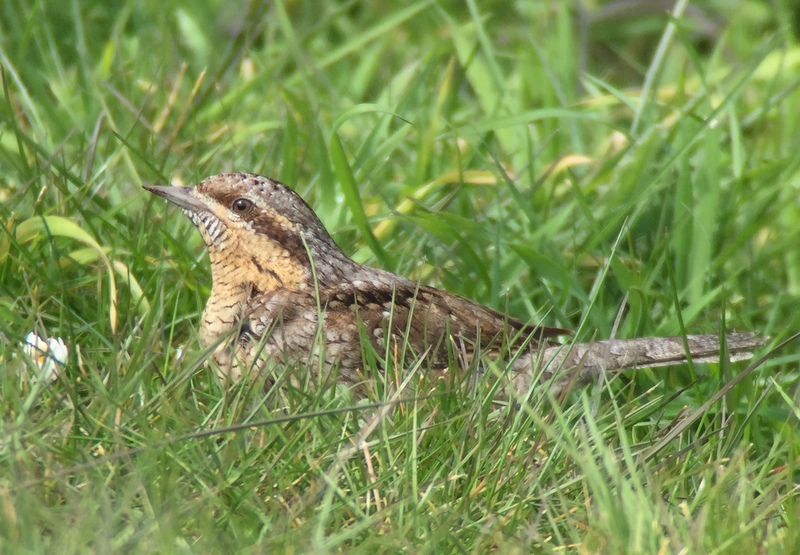 Wryneck – here’s a photo and video of it from Tuesday
Wryneck – here’s a photo and video of it from Tuesday
Back at the car, we were just loading up when a Cetti’s Warbler flew across between the bushes on the other side of the road. It landed briefly in the top of the clump of brambles where we could see it, before dropping back into cover. Then it was over to the visitor centre at Cley for lunch. It was so nice today, we even managed to make use of one of the picnic tables outside. We were glad we did, because several Swifts flew overhead while we ate. There were also loads of hirundines hawking for insects over the reserve this afternoon – Swallows, Sand Martins and House Martins – the most we have seen this year.
After lunch, we had a quick look at the Eye Field. There had apparently been several Yellow Wagtails flying west this morning, and we thought some might have landed here. As it was, there weren’t any there although we did hear one overhead. The pools on the edge of the Eye Field did produce a nice White Wagtail and a female Wheatear was on the grass behind. There were lots of Brent Geese preening and bathing on North Scrape. When we got back to the car, another Yellow Wagtail flew over going the other way and this one we saw as it went past.
We had planned to work our way back from Salthouse to the East Bank this afternoon, but as we drove past the latter we caught sight of a large white bird out on the far end of the Serpentine – a Spoonbill. So we parked here and walked out to get a better look at it. It was feeding in the pools at first, head down, sweeping its bill from side to side through the water as it walked. Then it came out onto the bank and started preening, so we could get a great look at it. It was a smart adult, with yellow-tipped bill, in breeding plumage with floppy crest and a yellowy-brown wash on its breast.
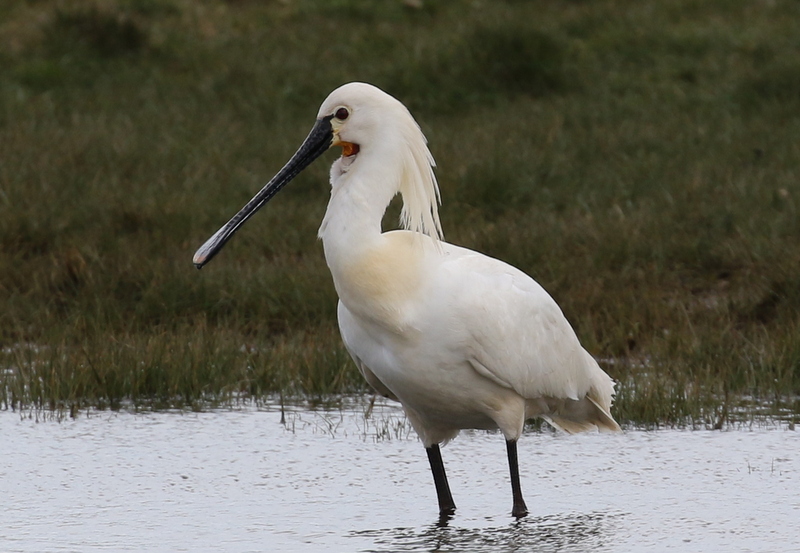 Spoonbill – this one taken here a couple of days ago
Spoonbill – this one taken here a couple of days ago
Looking back the other way, we saw a second Spoonbill emerge from one of the water-filled channels. Then the first took off and flew away to the west, before the second did the same a couple of minutes later, that one flying right past us as it did so.
 Spoonbill – this one flew straight past us today
Spoonbill – this one flew straight past us today
There was a nice selection of waders and ducks out on the grazing marshes here. As we scanned across, we could see several male Ruff of many different colour combinations. A little group of Dunlin was feeding on the muddy grass, many sporting black bellies now, along with a single Ringed Plover. We eventually managed to find a Little Ringed Plover too, extremely well camouflaged against the dry mud bank it was on.
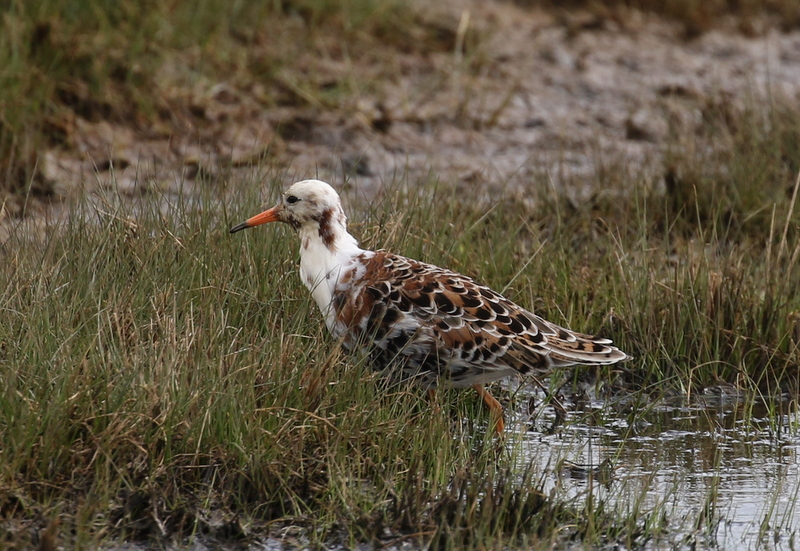 Ruff – the males come in a bewildering variety of colours now
Ruff – the males come in a bewildering variety of colours now
There are always lots of Lapwings and Redshank out here at this time of year, as this is where they breed. We were treated to quite a display from two Lapwings which chased and tumbled in the sky for several minutes this afternoon.
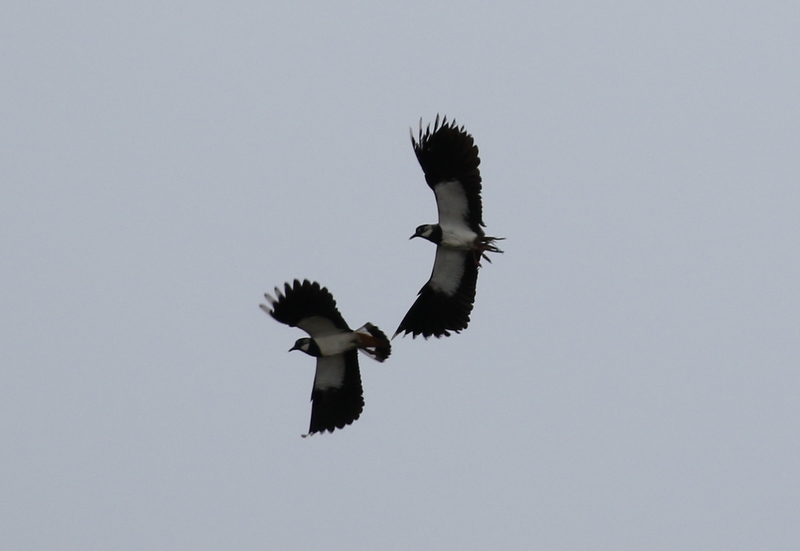 Lapwings – displaying over the grazing marshes
Lapwings – displaying over the grazing marshes
Even though most of them have long since departed on their way back to Russia for the breeding season, there are still a few lingering Wigeon here. On the other side of the bank, a Sedge Warbler was singing away very noisily but when it paused for breath we could hear a Reed Warbler singing too. It was good to listen to the two songs almost simultaneously, to really hear the differences between them. A Marsh Harrier was circling over the reeds beyond. Arnold’s Marsh is rather full of water at the moment, so a quick visit here didn’t add too much to the day’s list, beyond a better view of a Turnstone and a couple more Ringed Plovers.
We stopped at the Iron Road next. We were just explaining that this is a good place to look for Whimbrel when we found two in the field right next to us. We got out to have a better look at them, and although we spooked them they landed again only a little further over. We got them in the scope, so we could really see their prominent crown stripes.
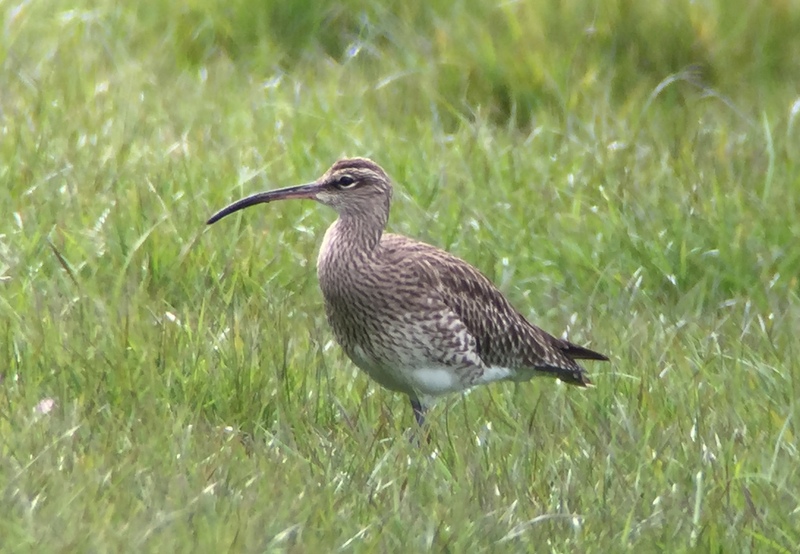 Whimbrel – like a small, short-billed Curlew
Whimbrel – like a small, short-billed Curlew
Scanning the rest of the field, we found two Curlew in here as well. Even better, they walked over to join the two Whimbrel, giving us a great side-by-side comparison. As well as the different head pattern, the Whimbrel were noticeably smaller, slimmer, darker, with a much shorter bill.
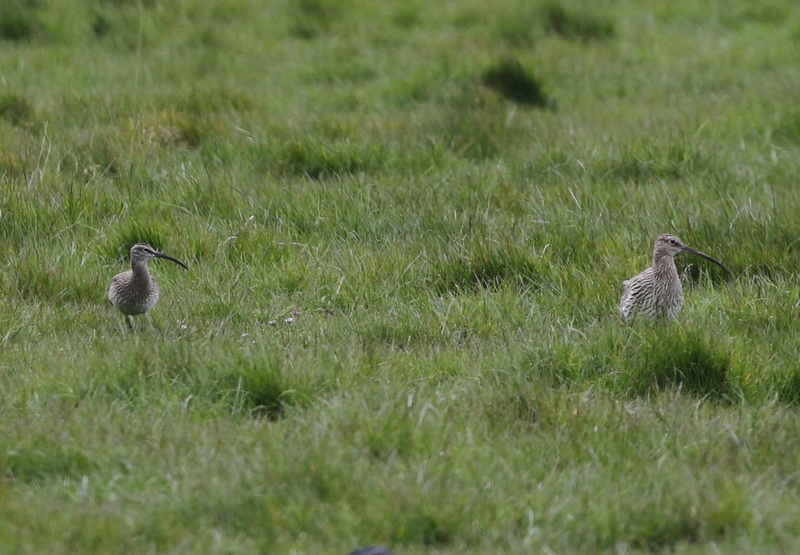 Whimbrel & Curlew – gave us a great side-by-side comparison
Whimbrel & Curlew – gave us a great side-by-side comparison
A quick stop down at Beach Road in Salthouse next did not produce the hoped for Yellow Wagtails on the ground, but did hold at least three Wheatears, including a particularly smart male not to far from the road.
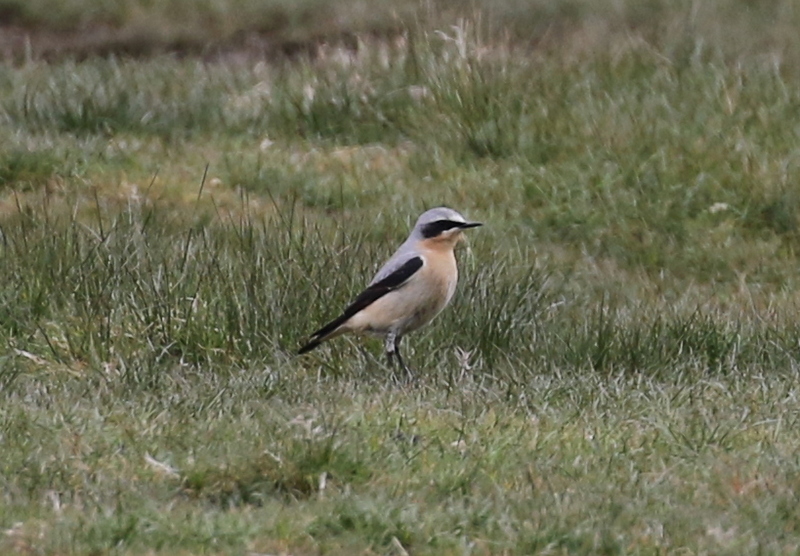 Wheatear – a very smart male at Salthouse
Wheatear – a very smart male at Salthouse
Our final destination of the day was Stiffkey Fen. As we got out of the car, a male Marsh Harrier flew across the field opposite. It had clouded over now, and we caught the very edge of a thankfully brief shower as it passed over us before we set off. Possibly as a consequence, it was a little quiet on the way out to the Fen this afternoon. A Kingfisher flying up low along the river was only heard.
From up on the seawall, we could see lots of Black-tailed Godwits out on the Fen and a couple in the channel down on the other side. We had intended to have a look at the Fen first, but with another shower blowing towards us, we elected to have a look at the harbour first.
There are lots of Brent Geese still out in the harbour – they should be on their way back towards Russia too soon. As well as many more Black-tailed Godwits, we found a few Grey Plover and Turnstone, plus a handful of Dunlin and a couple of Ringed Plover, but it was not the best time to be searching for waders here, with the tide at its lowest. Three Red-breasted Mergansers were distant out in the harbour, with lots of seals pulled up on the sandbars just beyond them.
 Brent Goose – there are lots still out in the harbour
Brent Goose – there are lots still out in the harbour
About fifty Sandwich Terns were in a little group down in the bottom of the ‘Pit’. There are meant to be over 2,000 of them back now, so most had obviously gone on a day trip somewhere else today. While we were standing admiring the harbour, a couple each of Swifts and House Martins flew west low overhead.
We walked back to the Fen, but even though the weather had now improved a bit, we couldn’t see a lot more on here. A Common Snipe was feeding along the edge of the reeds and a single Little Ringed Plover was on one of the islands. As we turned to leave, we picked up two adult Mediterranean Gulls flying past over the saltmarsh.
Then it was time to head for home, with the added bonus of a Red Kite which drifted across the road ahead of us on the way back.
















